Summary
Immunostaining to identify nuclear antigens expressed throughout the cell cycle provides a convenient way of assessing proliferating kinetics in tumours. We studied proliferation activity of gastric carcinomas by Ki-67 and PCNA immunostaining and the two methods were compared. The mode of tissue preparation differed, fresh frozen for Ki-67 and formalin-fixed paraffin-embedded for PCNA. Immunostaining with avidin-biotin was used in both. The labelling index (LI) and a semi-quantitative grading of cell proliferation were assessed in both markers. Significant correlation was shown between LI and grading with either Ki-67 and PCNA. However, no correlation was found between PCNA and Ki-67. This lack of relationship between the two markers may be attributed to a number of factors. 1. The most likely is the marked inter- and intra-tumour heterogeneity of gastric carcinomas reflected in high standard deviation values. 2. Preparation of tissue and small size sampling with Ki-67. 3. Long life of PCNA leading to detection of cells that have recently left the cell cycle. 4. One may be observing deregulated expression of DNA as seen in certain tumours. PCNA offers the advantage of being applicable to archival material.
Similar content being viewed by others
References
Ballantyne, K. C., James, P. D., Robins, R. A.,Baldwin, R. W. &Hardcastle, J. D. (1987) Flow cytometric analysis of the DNA content of gastric cancer.Br. J. Cancer 56, 52–4.
Bravo, R. &Macdonald-Bravo, M. (1987) Existence of two populations of cyclin/proliferating cell nuclear antigen during the cell cycle. Association with DNA replication sites.J. Cell. Biol. 105, 1549–54.
Bravo, R., Frank, R., Blundell, P. A. &Macdonald-Bravo, H. (1987) Cyclin/PCNA is the auxilliary protein of DNA polymerase alpha.Nature 326, 515–7.
Brown, D. C. &Gatter K. C. (1990) Review. Monoclonal antibody Ki-67: its use in histopathology.Histopathology 17, 489–503.
Chang, C. D., Ottavio, L., Travalli, S., Lipson, K. E. &Baserga, R. (1990) Transcriptional and post transcriptional regulation of the proliferating cell nuclear antigen gene.Mol. Cell Biol. 10, 3289–96.
Filipe, M. I., Rosa, J., Sandey, A. Imrie, R., Ormerod, M. G. &Morris, R. (1991) Is DNA ploidy and proliferative activity of prognostic value in advanced gastric carcinoma?Hum. Pathol. 22, 373–8.
Gerdes, J., Schwab, U., Lemke, H. &Stein, H. (1983) Production of a mouse monoclonal antibody reactive with a human nuclear antigen associated with cell proliferation.Int. J. Cancer 31, 13–20.
Hall, P. A. &Levison, D. A. (1990) Review: assessment of cell proliferation in histological material.J. Clin. Pathol. 43, 184–192.
Hall, P. A., Levison, D. A., Woods, A. L., Yu, C. C-W., Kellock, D. B., Watkins, J. A. Barnes, D. M., Gillett, C. E., Camplejohn, R. I., Dover, R. I., Waseem, N. H. &Lane, D. P. (1990) Proliferating cell nuclear antigen (PCNA) immunolocalisation in paraffin sections: an index of cell proliferation with evidence of deregulated expression in some neoplasms.J. Pathol. 162, 285–94.
Jain, S., Filipe, M. I., Hall, P. A., Waseem, N., Lane, D. P. &Levison, D. A. (1991) Prognostic value of proliferating cell nuclear antigen in gastric carcinoma.J. Clin. Pathol. 44, 655–9.
Lauren, P. (1965) The two histological main types of gastric carcinoma. Diffuse and the so-called intestinal type carcinoma. An attempt at histoclinical classification.Acta Pathol. Microbiol. Scand. 64, 31–49.
Ming, S-C. (1977) Gastric carcinoma: a pathological classification.Cancer 39, 2475–85.
Oota, K. &Sobin, L. H. (1977)Histological Typing of Gastric and Oesophageal Tumours. International Histological Classification of Tumours. No. 18. World Health Organisation, Geneva.
Ottavio, L., Chang, C. D., Rizzo, M. G., Travalli, S. &Casadevall, C. (1990) Importance of introns in the growth regulation of mRNA levels of the proliferating cell nuclear antigen gene.Mol. Cell Biol. 10, 303–9.
Quinn, C. M. &Wright, N. A. (1990) The clinical assessment of proliferation and growth in human tumours: evaluation of methods and applications as prognostic variables.J. Pathol. 160, 93–102.
Ribeiro, M. M., Seixas, M. &Sobrinho-Simoes, M. A. (1988) Prognosis in gastric carcinoma. The pre-eminence of staging and the futility of histological classification. InDigestive Disease Pathology (edited byWatanabe, S., Wolff, M. &Sommers, S.), Vol. 1. Philadelphia: Field & Wood.
Sasaki, K., Matsumura, K., Tsuji, T., Shinozaki, F. &Takahashi, M. (1988) Relationship between labelling indices of Ki67 and BrdrUd in human malignant tumours.Cancer 62, 989–93.
Schwarting, R., Gerdes, J., Niehus, J., Jaesche, L. &Stein, H. (1986) Determination of the growth fraction in cell suspensions by flow cytometry using the monoclonal antibody Ki67.J. Immunol. Meth. 90, 365–71.
Silvestrini, R., Costa, A., Vereroni, S., Del Bino, G. &Persici, P. (1988) Comparative analysis of different approaches to investigate cell kinetics.Cell Tissue Res. 21, 123–31.
Snedecor, G. W. & Cochran, W. G. (1980)Statistical Methods. 7th edn. pp. 243–4. Iowa State University Press.
Verheijen, R., Kuijpers, H. J. H. &Van Driel, R. (1989) Ki67 detects a nuclear matrix associated proliferation antigen. II. Localization in mitotic cells and association with chromosomes.J. Cell. Sci. 92, 531–40.
Waseem, N. H. &Lane, D. P. (1990) Monoclonal antibody analysis of the proliferating cell nuclear antigen (PCNA). Structural conservation and the detection of a nucleolar form.J. Cell. Sci. 96, 121–9.
Woods, A. L., Hall, P. A., Shepherd, N. H., Hanby, A. M., Waseem, N. H., Lane, D. P. &Levison, D. A. (1990) The prognostic value of PCNA (proliferating cell nuclear antigen) immunostaining in gastro-intestinal lymphomas.J. Pathol. 161, 342A.
Yu, C. C-W., Woods, A. L. &Levison, D. A. (1991) The assessment of cellular proliferation by immunohistochemistry: a review of currently available methods and their applications. InAssessment of Cell Proliferation in Clinical Practice (edited byHall, P., Levison, D. A. &Wright, N. A.) Heidelberg: Springer-Verlag (in press).
Author information
Authors and Affiliations
Rights and permissions
About this article
Cite this article
Rosa, J.C., Mendes, R., Filipe, M.I. et al. Measurement of cell proliferation in gastric carcinoma: comparative analysis of Ki-67 and proliferative cell nuclear antigen (PCNA). Histochem J 24, 93–101 (1992). https://doi.org/10.1007/BF01082445
Received:
Revised:
Issue Date:
DOI: https://doi.org/10.1007/BF01082445




